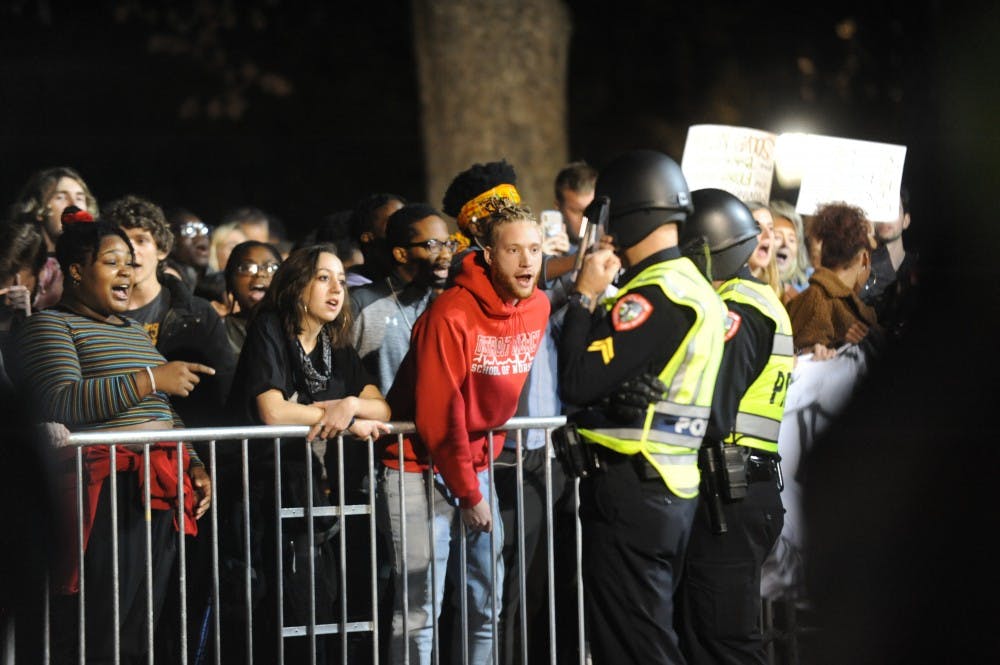It is not yet clear where the funding for such a center would come from, although Folt said the BOT would likely ask the Board of Governors for funding for the project.
“This is so important to us that we are going to make it happen,” Folt said.
The plan also includes efforts to continue and expand the historic contextualization of campus and the construction of a “commemorative space” to serve as a more reflective and inclusive gateway to campus where Silent Sam once stood. Folt mentioned that part of the University’s re-contextualization plan will include renovations of the Unsung Founders Memorial, a monument honors people of color “bond and free” who have shaped UNC’s history.
Chancellor Folt expressed multiple times at the meeting that it was neither her nor the board’s preference that the monument remain on campus, but current state law makes a removal impossible.
“I have a preference to move it off campus but, like everyone here, I swore to obey the law,” Folt said. “And sometimes you don’t agree with laws. But I don’t have the privilege of choosing which laws I agree with and which ones I do not.”
Folt was referring to section 100-2.1 of the N.C. General Statutes, which states that any “objects of remembrance” on public property may not be permanently removed, only relocated.
The North Carolina Museum of History, at one point considered as a potential relocation site for the monument, was therefore unable to take the monument without breaking the law. Taking possession of the monument would cost the museum about $2 million, Folt said.
An editorial published by the News & Observer shortly after Silent Sam was pulled down argued that the University should have fought harder to have the law changed or addressed.
To get the day's news and headlines in your inbox each morning, sign up for our email newsletters.
“While the University is probably reading state law correctly, it could and should have urged legislators to reconsider the law, or to at least make an exception in this unique case,” the editorial stated.
Folt made it clear that neither she nor the board desire to deny the complex or problematic portions of UNC’s history.
“The contextualization and the history and the access to this history is what is most important,” said board member Chuck Duckett. “It’s an accurate history that’s accessible. We are a university and it speaks to our mission.”
Two members of the Board of Trustees opposed the plan set forth Monday: Allie McRae and UNC Student Body President Savannah Putnam.
“I simply cannot support putting the Confederate monument back on campus,” Putnam said during the meeting.
Bill Keyes, the only Black member of the BOT spoke at length about his opposition to the plan but ultimately said it was the best that could be done under the current law and voted in favor of it.
WUNC reported Thursday that Keyes worked for South Africa's 1980s apartheid government. He declined to speak to The Daily Tar Heel about the report prior to Monday's meeting, but would comment on Silent Sam.
“Work that I did 30 years ago has absolutely no impact on what we’re doing,” Keyes said on Thursday. “More discussion about that, I think, really is a distraction from the real discussion about Silent Sam, how Confederate statues, about the way that people of color perceive, the way the Black people perceive the statues — that is a huge discussion.”
The plan set forth by the BOT today is subject to approval by the UNC Board of Governors and the North Carolina Historical Commission. The next BOG meeting is scheduled for Dec. 14.
Folt said she could not speak for how the BOG would move forward with the proposal or what the timeline may look like for the plan that she and the board set forth today.
@hannaherinlang
university@dailytarheel.com




